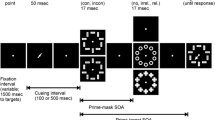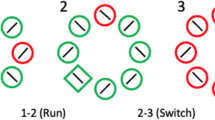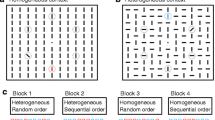Abstract
The visual system has to distinguish between information that is relevant and irrelevant for current behavioral goals. This is especially important in automatized responses. Here, we study how task-irrelevant distractors with task-relevant features gain access to speeded, automatized motor responses in a response-priming paradigm. In two tasks, we present distractors either together with primes or with targets, and vary the consistency between primes/targets and distractors as well as the number and saturation of distractors. Our findings are consistent with accounts where primes, targets, and distractors contribute to response activations by sequential feedforward response activation. In addition, conditions with especially salient target–distractors seem to lead to active inhibition of the primed response that occurs late in the trial. We replicate all main findings in a control experiment. Together, our findings show that the effects of distractors depend on (i) their stimulus characteristics as well as on (ii) the phase at which they enter visual processing—with effects ranging from feedforward activation to controlled inhibition of responses.







Similar content being viewed by others
Notes
We thank an anonymous reviewer for detailing the following argument.
References
Albrecht, T., Klapötke, S., & Mattler, U. (2010). Individual differences in metacontrast masking are enhanced by perceptual learning. Consciousness and Cognition, 19(2), 656–666. https://doi.org/10.1016/j.concog.2009.12.002.
Ansorge, U., Horstmann, G., & Worschech, F. (2010). Attentional capture by masked colour singletons. Vision Research, 50(19), 2015–2027. https://doi.org/10.1016/j.visres.2010.07.015.
CIE. (1978). Recommendations on uniform color scales: Color-difference equations, psychometric color terms. Supplement No. 2 to CIE publication No. 15 (E-1.3.1) 1971/(TC-1.3.).
Cohen, J. (1988). Statistical power analysis for the behavioral sciences (2nd ed.). Hillsdale: L. Erlbaum Associates.
Colonius, H., & Vorberg, D. (1994). Distribution inequalities for parallel models with unlimited capacity. Journal of Mathematical Psychology, 38(1), 35–58. https://doi.org/10.1006/jmps.1994.1002.
Corballis, M. (2002). Hemispheric interactions in simple reaction time. Neuropsychologia, 40(4), 423–434. https://doi.org/10.1016/s0028-3932(01)00097-5.
Cousineau, D. (2005). Confidence intervals in within-subject designs: a simpler solution to Loftus and Masson’s method. Tutorial in Quantitative Methods for Psychology, 1, 42–45.
Eimer, M., & Schlaghecken, F. (2002). Links between conscious awareness and response inhibition: Evidence from masked priming. Psychonomic Bulletin & Review, 9(3), 514–520.
Eriksen, B. A., & Eriksen, C. W. (1974). Effects of noise letters upon the identification of a target letter in a nonsearch task. Perception & Psychophysics, 16, 143–149.
Flannigan, J. C., Chua, R., & Cressman, E. K. (2016). The rapid-chase theory does not extend to movement execution. Consciousness and Cognition, 42, 75–92. https://doi.org/10.1016/j.concog.2016.03.007.
Francis, G., Manassi, M., & Herzog, M. H. (2017). Neural dynamics of grouping and segmentation explain properties of visual crowding. Psychological Review, 124(4), 483.
Gegenfurtner, K. R., & Kiper, D. C. (2003). Color vision. Annual Review of Neuroscience, 26, 181–206.
Jacob, J., Breitmeyer, B. G., & Trevino, M. (2013). Tracking the first two seconds: Three stages of visual information processing? Psychonomic Bulletin & Review, 20(6), 1114–1119. https://doi.org/10.3758/s13423-013-0482-4.
Jaśkowski, P., & Przekoracka-Krawczyk, A. (2005). On the role of mask structure in subliminal priming. Acta Neurobiologiae Experimentalis, 65, 409–417.
Kaneko, S., Anstis, S., & Kuriki, I. (2017). Brief presentation enhances various simultaneous contrast effects. Journal of Vision, 17(4), 7. (1–13).
Kleiner, M., Brainard, D., & Pelli, D. (2007). What’s new in Psychtoolbox-3? Perception, 36(14), 1. https://doi.org/10.1068/v070821.
Klotz, W., Heumann, M., Ansorge, U., & Neumann, O. (2007). Electrophysiological activation by masked primes: Independence of prime-related and target-related activities. Advances in Cognitive Psychology, 3(4), 449–465. https://doi.org/10.2478/v10053-008-0008-1.
Kunde, W., Kiesel, A., & Hoffmann, J. (2003). Conscious control over the content of unconscious cognition. Cognition, 88(2), 223–242. https://doi.org/10.1016/s0010-0277(03)00023-4.
Lamme, V. A., & Roelfsema, P. R. (2000). The distinct modes of vision offered by feedforward and recurrent processing. Trends in Neurosciences, 23(11), 571–579. https://doi.org/10.1016/s0166-2236(00)01657-x.
Lavie, N. (1995). Perceptual load as a necessary condition for selective attention. Journal of Experimental Psychology: Human Perception and Performance, 21, 451–468.
Lavie, N. (2005). Distracted and confused? Selective attention under load. Trends in Cognitive Sciences, 9, 75–82.
Lavie, N., & Cox, S. (1997). On the efficiency of attentional selection: Efficient visual search results in inefficient rejection of distraction. Psychological Science, 8, 395–398.
Lavie, N., Lin, Z., Zokaei, N., & Thoma, V. (2009). The role of perceptual load in object recognition. Journal of Experimental Psychology: Human Perception and Performance, 35(5), 1346–1358. https://doi.org/10.1037/a0016454.
Leuthold, H., & Kopp, B. (1998). Mechanisms of priming by masked stimuli: Inferences from event-related brain potentials. Psychological Science, 9(4), 263–269. https://doi.org/10.1111/1467-9280.00053.
Levi, D. M. (2008). Crowding—an essential bottleneck for object recognition: A mini-review. Vision Research, 48(5), 635–654. https://doi.org/10.1016/j.visres.2007.12.009.
Levine, T. R., & Hullett, C. R. (2002). Eta squared, partial eta squared, and misreporting of effect size in communication research. Human Communication Research, 28(4), 612–625. https://doi.org/10.1111/j.1468-2958.2002.tb00828.x.
Maljkovic, V., & Nakayama, K. (1994). Priming of pop-out. I. Role of features. Memory & Cognition, 22, 657–672.
Manassi, M., Sayim, B., & Herzog, M. H. (2012). Grouping, pooling, and when bigger is better in visual crowding. Journal of Vision, 12(10), 13.
Mattler, U., & Palmer, S. (2012). Time course of free-choice priming effects explained by a simple accumulator model. Cognition, 123(3), 347–360. https://doi.org/10.1016/j.cognition.2012.03.002.
Miller, J. (1982). Divided attention: Evidence for coactivation with redundant signals. Cognitive Psychology, 14(2), 247–279. https://doi.org/10.1016/0010-0285(82)90010-x.
Miller, J., & Ulrich, R. (2003). Simple reaction time and statistical facilitation: A parallel grains model. Cognitive Psychology, 46(2), 101–151. https://doi.org/10.1016/s0010-0285(02)00517-0.
Neumann, O. (1990). Direct parameter specification and the concept of perception. Psychological Research, 52(2–3), 207–215. https://doi.org/10.1007/bf00877529.
Ocampo, B., & Finkbeiner, M. (2013). The negative compatibility effect with relevant masks: A case for automatic motor inhibition. Frontiers in Psychology, 4, 822. https://doi.org/10.3389/fpsyg.2013.00822.
Panis, S., & Schmidt, T. (2016). What is shaping RT and accuracy distributions? Active and selective response inhibition causes the Negative Compatibility Effect. Journal of Cognitive Neuroscience. https://doi.org/10.1162/jocn_a_00998.
Raab, D. H. (1962). Division of psychology: Statistical facilitation of simple reaction times. Transactions of the New York Academy of Sciences, 24, 574–590. https://doi.org/10.1111/j.2164-0947.1962.tb01433.x.
Rosen, S., Chakravarthi, R., & Pelli, D. G. (2014). The Bouma law of crowding, revised: Critical spacing is equal across parts, not objects. Journal of Vision, 14, 1–15.
Schmidt, T. (2002). The finger in flight: Real-time motor control by visually masked color stimuli. Psychological Science, 13(2), 112–118. https://doi.org/10.1111/1467-9280.00421.
Schmidt, F., Haberkamp, A., & Schmidt, T. (2011a). Dos and don’ts in response priming research. Advances in Cognitive Psychology, 7, 120–131. https://doi.org/10.2478/v10053-008-0092-2.
Schmidt, T., Haberkamp, A., Veltkamp, G. M., Weber, A., Seydell-Greenwald, A., & Schmidt, F. (2011b). Visual processing in rapid-chase systems: Image processing, attention, and awareness. Frontiers in Psychology, 2, 169. https://doi.org/10.3389/fpsyg.2011.00169.
Schmidt, T., Hauch, V., & Schmidt, F. (2015). Mask-triggered thrust reversal in the negative compatibility effect. Attention, Perception & Psychophysics, 77(7), 2377–2398. https://doi.org/10.3758/s13414-015-0923-4.
Schmidt, T., Niehaus, S., & Nagel, A. (2006). Primes and targets in rapid chases: Tracing sequential waves of motor activation. Behavioral Neuroscience, 120(5), 1005–1016. https://doi.org/10.1037/0735-7044.120.5.1005.
Schmidt, T., & Schmidt, F. (2009). Processing of natural images is feedforward: A simple behavioral test. Attention, Perception & Psychophysics, 71(3), 594–606. https://doi.org/10.3758/app.71.3.594.
Schmidt, F., & Schmidt, T. (2013). Grouping principles in direct competition. Vision Research, 88, 9–21. https://doi.org/10.1016/j.visres.2013.06.002.
Schmidt, T., & Schmidt, F. (2018). An accumulator model for primes and targets with independent response activation rates: Basic equations for average response times. arXiv:1804.08513[q-bio.NC].
Schmidt, F., & Vancleef, K. (2016). Response priming evidence for feedforward processing of snake contours but not of ladder contours and textures. Vision Research, 126, 174–182.
Schmidt, F., Weber, A., & Schmidt, T. (2014). Activation of response force by self-splitting objects: Where are the limits of feedforward Gestalt processing? Journal of Vision. https://doi.org/10.1167/14.9.20.
Schubert, T., Palazova, M., & Hutt, A. (2013). The time course of temporal attention effects on nonconscious prime processing. Attention, Perception & Psychophysics, 75(8), 1667–1686. https://doi.org/10.3758/s13414-013-0515-0.
Schwarz, W., & Mecklinger, A. (1995). Relationship between flanker identifiability and compatibility effect. Perception & Psychophysics, 57, 1045–1052.
Townsend, J. T., & Nozawa, G. (1995). Spatio-temporal properties of elementary perception: An investigation of parallel, serial, and coactive theories. Journal of Mathematical Psychology, 39(4), 321–359. https://doi.org/10.1006/jmps.1995.1033.
Vath, N., & Schmidt, T. (2007). Tracing sequential waves of rapid visuomotor activation in lateralized readiness potentials. Neuroscience, 145(1), 197–208. https://doi.org/10.1016/j.neuroscience.2006.11.044.
Vorberg, D., Mattler, U., Heinecke, A., Schmidt, T., & Schwarzbach, J. (2003). Different time courses for visual perception and action priming. Proceedings of the National academy of Sciences of the United States of America, 100(10), 6275–6280. https://doi.org/10.1073/pnas.0931489100.
Acknowledgements
Thanks to Jennifer Prodan for data collection and to Brenda Ocampo, Steven Haase, and three anonymous reviewer for helpful comments and suggestions on an earlier version of the manuscript.
Author information
Authors and Affiliations
Corresponding author
Ethics declarations
Conflict of interest
The authors declare that they have no conflict of interest.
Ethical approval
All procedures performed in studies involving human participants were in accordance with the ethical standards of the institutional research committee and with the 1964 Helsinki declaration and its later amendments or comparable ethical standards.
Informed consent
Informed consent was obtained from all individual participants included in the study.
Additional information
Publisher's Note
Springer Nature remains neutral with regard to jurisdictional claims in published maps and institutional affiliations.
Appendix
Appendix
See Tables 2, 3, 4, and 5 and Figs. 8, 9, 10, 11
Error rates of the prime–distractor task in Experiment 1. For details see Fig. 2
Error rates of the target–distractor task in Experiment 1. For details see Fig. 2
Response times in the prime–distractor task in Experiment 1. Response times are plotted as a function of response time bins (from fastest to slowest responses, calculated separately for each participant and condition), line color denotes prime–target consistency (consistent: blue, inconsistent: red), line style denotes prime–distractor consistency (consistent: solid, inconsistent: dashed). The baseline without distractors is shown within the gray frame, the other line graphs show response times as a function of distractor saturation (rows) and number of distractors (columns). Transparent error margins denote standard errors
Response times of the target–distractor task in Experiment 1. For details see Fig. 10
Rights and permissions
About this article
Cite this article
Schmidt, F., Schmidt, T. Response control by primes, targets, and distractors: from feedforward activation to controlled inhibition. Psychological Research 85, 195–213 (2021). https://doi.org/10.1007/s00426-019-01236-9
Received:
Accepted:
Published:
Issue Date:
DOI: https://doi.org/10.1007/s00426-019-01236-9








